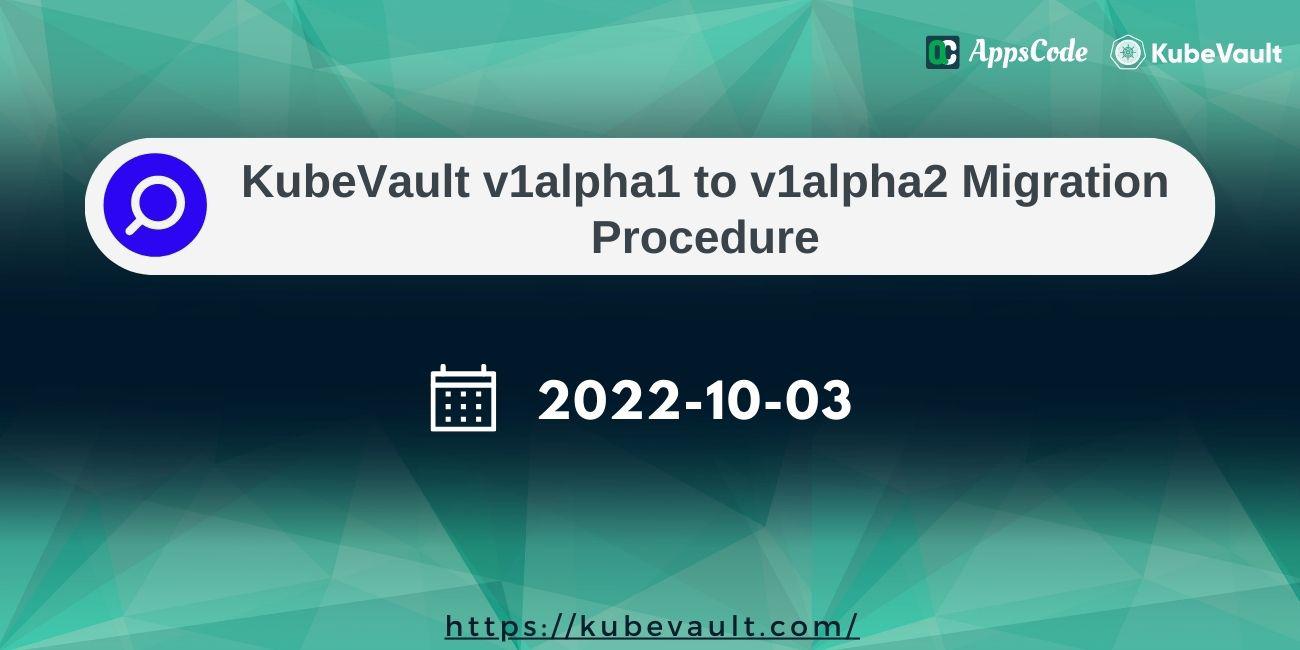
KubeVault is a Git-Ops ready, production-grade solution for deploying and configuring HashiCorp Vault on Kubernetes.
Background
This blog is based on our experience upgrading one of our KubeVault Enterprise users from KubeVault v1alpha1 to KubeVault v1alpha2.
The same steps can be followed carefully to get your KubeVault deployment upgraded to the latest version.
Why the Upgrade?
We wanted to ship all the new features & fixes to our client that were added in KubeVault Operator, v1alpha2 APIs & KubeVault CLI.
Also, the TLS certificates that were issued were about to expire after a year. So, in order to upgrade the Operator, CLI & TLS certificates, the upgrade was necessary.
Some KubeVault Operator v1alpha2 features are Vault Ops-request, Cert-manager support, Recommendation generation for managing Vault TLS, updated Health Checker, support for Pod Disruption Budget, updated root-token & unseal-keys naming convention for multi-cluster usage, etc.
And, from KubeVault CLI end you can now get, set, delete, list, and sync vault unseal-keys and root-token stored in various KMS stores.
If you want to learn more about KubeVault features, please check this out.
Upgrade Procedure
Prior to the upgrade, the KubeVault CLI that was in use was in version v0.6.0-alpha.0 & the Operator version was v2021.10.11.
Here’s the commands for installing the respective versions:
# to install KubeVault CLI v0.6.0-alpha.0
$ curl -o kubectl-vault.tar.gz -fsSL https://github.com/kubevault/cli/releases/download/v0.6.0-alpha.0/kubectl-vault-linux-amd64.tar.gz \
&& tar zxvf kubectl-vault.tar.gz \
&& chmod +x kubectl-vault-linux-amd64 \
&& sudo mv kubectl-vault-linux-amd64 /usr/local/bin/kubectl-vault \
&& rm kubectl-vault.tar.gz LICENSE.md
# to install KubeVault Operator v2021.10.11
$ helm install kubevault appscode/kubevault \
--version v2021.10.11 \
--namespace kubevault --create-namespace \
--set kubevault-operator.apiserver.enableValidatingWebhook=false \
--set-file global.license=/path/to/vault/license.txt
The Unsealer mode used by them was AWS KMS & Storage used as AWS S3. The VaultServer configuration used is similar to the one given below.
apiVersion: kubevault.com/v1alpha1
kind: VaultServer
metadata:
name: vault
namespace: default
spec:
replicas: 1
tls:
certificates:
- alias: ca
- alias: server
monitor:
agent: prometheus.io
authMethods:
- path: kubernetes
type: kubernetes
backend:
s3:
bucket: <bucket-name>
region: <bucket-region>
unsealer:
mode:
awsKmsSsm:
kmsKeyID: <kms-key-id>
region: <kms-region>
secretShares: 1
secretThreshold: 1
version: 0.11.5
Using the KubeVault CLI, we got the decrypted root-token from AWS KMS, exported it in the environment variable & checked out the secrets stored in KV Secret Engine.
# previous root-token & unseal-keys naming convention
vault-root-token: <root-token>
vault-unseal-key-0: <unseal-key-0>
# get the root-token using KubeVault CLI
$ kubectl vault get-root-token vaultserver vault
# Commands to interact with Vault
$ kubectl exec -it vault-0 vault -- /bin/sh
$ export VAULT_TOKEN=<token>
$ export VAULT_ADDR='https://127.0.0.1:8200'
$ export VAULT_SKIP_VERIFY=true
# Check out the secrets to ensure that they remain intact after the upgrade procedure
$ vault secrets list
$ vault kv get <secret-path>
Uninstall the Older Operator
# uninstall kubevault older operator
$ helm uninstall kubevault --namespace kubevault
# in case any of these resources remain after helm uninstall, use kubectl delete <resource> -l app.kubernetes.io/name=kubevault-operator
$ kubectl delete mutatingwebhookconfiguration -l app.kubernetes.io/name=kubevault-operator
$ kubectl delete validatingwebhookconfiguration -l app.kubernetes.io/name=kubevault-operator
$ kubectl delete apiservices -l app.kubernetes.io/name=kubevault-operator
Install the Latest Operator & CLI
# Install KubeVault CLI version v0.10.0
$ curl -o kubectl-vault.tar.gz -fsSL https://github.com/kubevault/cli/releases/download/v0.10.0/kubectl-vault-linux-amd64.tar.gz \
&& tar zxvf kubectl-vault.tar.gz \
&& chmod +x kubectl-vault-linux-amd64 \
&& sudo mv kubectl-vault-linux-amd64 /usr/local/bin/kubectl-vault \
&& rm kubectl-vault.tar.gz LICENSE.md
# Install the KubeVault Operator version v2022.09.22
$ helm install kubevault appscode/kubevault \
--version v2022.09.22 \
--namespace kubevault --create-namespace \
--set-file global.license=/path/to/vault/license.txt
Now, if the Vault Pod is restarted, it’d expect the root-token & unseal-keys in the new naming convention which is: k8s.<kubevault.com or cluster uid>.namespace.name.
So, before doing that we must update the root token & unseal keys in the new naming convention. We used the KubeVault CLI sync command to do that.
# Sync the root-token & unseal-keys
# check the kms & ensure that root-token & unseal-keys are updated according to new naming convention
# old root-token & unseal-keys are also there for safety purpose
$ kubectl vault root-token sync vaultserver vault
$ kubectl vault unseal-key sync vaultserver vault
Update the TLS Certificates
We decided to go with cert-manager managed certificates this time. So, we first installed Cert-manager in our client cluster.
Using the existing CA certs we created an Issuer & updated the VaultServer spec along with proper duration. To install Cert-manager visit here
.
# Vault Issuer created using the existing vault-ca-certs
apiVersion: cert-manager.io/v1
kind: Issuer
metadata:
name: vault-issuer
namespace: default
spec:
ca:
secretName: vault-ca-certs
# VaultServer spec with Issuer Ref & updated certificates duration
tls:
issuerRef:
apiGroup: "cert-manager.io"
kind: Issuer
name: vault-issuer
certificates:
- alias: ca
secretName: vault-ca-certs
- alias: server
duration: "8952h"
secretName: vault-server-certs
- alias: client
duration: "8952h"
secretName: vault-client-certs
Now, all that was required was to run a Vault Ops-request to rotate the VaultServer TLS. Once, the Ops-request was successful
Vault Pod came up with updated TLS certificates. Rotate TLS Ops-request looks similar to the one given below:
apiVersion: ops.kubevault.com/v1alpha1
kind: VaultOpsRequest
metadata:
name: renew-tls-2022
namespace: default
spec:
type: ReconfigureTLS
vaultRef:
name: vault
tls:
issuerRef:
apiGroup: "cert-manager.io"
kind: Issuer
name: vault-issuer
rotateCertificates: true
Once the upgrade was done, we went through the similar approach described above to verify the secrets in SecretEngine.
What Next?
Please try the latest release and give us your valuable feedback. If you want to install KubeVault, please follow the installation instruction from here .
Support
To speak with us, please leave a message on our website .
To receive product announcements, follow us on Twitter .
If you have found a bug with KubeVault or want to request new features, please file an issue .









